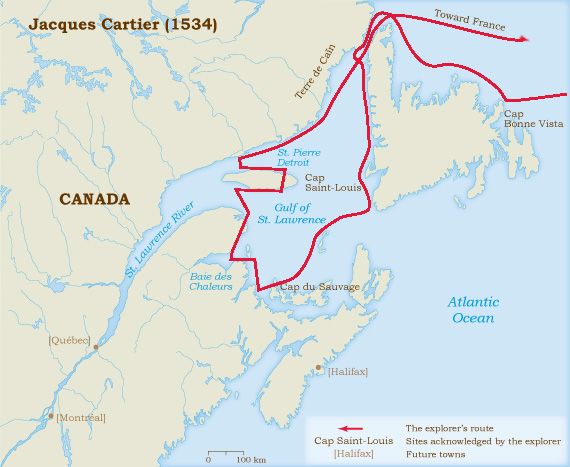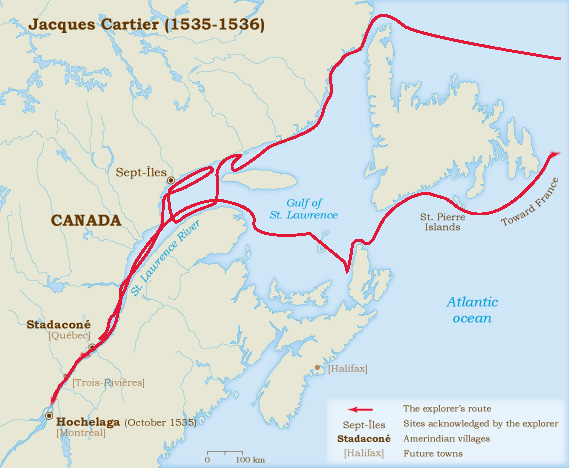what did jacques cartier find on his exploration
We do not know how Jacques Cartier learned the art of navigation, just Saint-Malo, the town where he was built-in betwixt the summer and wintertime of 1491, was at the time one of the about important ports in Europe. In 1524 he probably accompanied Giovanni da Verrazzano on unofficial explorations initiated past the male monarch of France. Some x years later, Jacques Cartier was a sufficiently experienced navigator to exist asked by Francis I to undertake the official exploration of Due north America. At that place is no doubt that he was already familiar with the sea road that he took in 1534.
Routes


To the New Lands
On March 19, 1534, Cartier was assigned the mission of "undertaking the voyage of this kingdom to the New Lands to observe certain islands and countries where there are said to be great quantities of gold and other riches". The following Apr twenty, the navigator from Saint-Malo cast off with two ships and a coiffure of 61. Twenty days later he reached Newfoundland. The exploration began in an area frequented by Breton fishermen: from the Baie des Châteaux (Strait of Belle Isle) to southern Newfoundland. After erecting a cross at Saint-Servan on the north coast of the Gulf, Cartier tacked to the south. He first encountered the Magdalen Islands, and and so set form for present-twenty-four hours Prince Edward Island, declining to notice that it was in fact an island.
A Prevarication and A Claiming of Possession
Cartier then moved on to Chaleur Bay, where he encountered some Micmacs on July 7. The talks were accompanied past a swapping of items, which history has recorded as the beginning act of trade between the French and Amerindians. Before long after, Cartier reached Gaspé Bay.
More than 200 Iroquois from Stadacona (Québec) were on the peninsula to fish. Initially trusting and cordial, relations were tarnished when Jacques Cartier claimed possession of the territory on July 24. The 30-human foot cross he erected at Pointe-Penouille seemed improper to Donnacona, the Native primary. Fearing the consequences of this discontent, Cartier lied, describing the cross as an insignificant landmark.
Jacques Cartier in Gaspé On the 25th he left the Gaspé area, heading for the Gulf of St. Lawrence. Later on navigating the strait separating Anticosti Island from the n shore, he fix off again for Saint-Malo, where he landed on September v. The St. Lawrence River had non been discovered.
Revelations of the Amerindian Guides
Jacques Cartier arrived in France with 2 precious trophies: Domagaya and Taignoagny, the sons of Donnacona, whom he had convinced to come up with him. They told him of the St. Lawrence River and the "Kingdom of the Saguenay", the objectives of his second voyage upon which he set forth on May 19, 1535. Cartier had been persuasive: his crew had doubled and he had command of three ships: the Grande Hermine, Petite Hermine and Émérillon.
Fifty days after putting to sea, a offset vessel laid ballast off the shores of Newfoundland. On July 26 the convoy was reunited, and exploration could begin once again. On August x, the 24-hour interval of St. Lawrence, the explorer gave the saint'south name to a petty bay. Cartographers later applied it to the the "keen river of Hochelaga and route to Canada" leading to the interior of the continent, "so long that no man has seen its end".
From the Saguenay to Hochelaga
Sailing along the river to Stadacona (Québec), the ships passed Anticosti Island and the oral fissure of the Saguenay. Cartier established his headquarters on the Sainte-Croix (Saint-Charles) river, and five days later boarded the Émérillon to travel to Hochelaga (Montreal). Leaving the ship in Lake Saint-Pierre, he proceeded in a small craft to the Iroquois hamlet, where he arrived on Oct 2.
In that location were near 2,000 people living there. The island and village were disregarded by a mountain, which he named mount Royal. He was taken there past his hosts, who spoke to him of the riches of the w, and again of the "Kingdom of the Saguenay". The rapids north and south of Montreal Island prevented him from continuing his route to the west. Cartier had to return to harbour on the Saint-Charles river, where he found that relations with the Iroquois had become more acrimonious. The threat of an early winter lay before the Frenchmen.
Isolation, Cold and Scurvy
From mid-November, the ships were imprisoned in the water ice. December began with an epidemic of scurvy. The Iroquois, the first afflicted, were boring in delivering upwards the secret of anedda, a white cedar tea which would save them. Of the 100 Frenchmen afflicted, 25 died.
On May 3, Cartier planted a cross on the site where he had just wintered. The aforementioned day, he seized nearly ten Iroquois, 1 of them Donnacona, the simply one who was able to "relate to the King the marvels he had seen in the western lands".
The voyage back began 3 days subsequently, without the Petite Hermine. Following a swerve along the Newfoundland coast, Jacques Cartier discovered the strait which bears the name of the explorer Giovanni Caboto. On July 16, 1536, Cartier was once more in Saint-Malo.
The Colonization of Canada
On October 17, 1540, Francis I ordered the Breton navigator to return to Canada to lend weight to a colonization project of which he would be "captain general". But on Jan 15, 1541 Cartier was supplanted by Jean-François de La Roque de Roberval, a Huguenot courtier.
Authorized to leave by Roberval, who was awaiting the commitment of artillery and merchandise, Jacques Cartier departed from Saint-Malo on May 23, 1541. He led five vessels "well provisioned with victuals for 2 years", including the Grande Hermine, Émérillon, Saint-Brieux and Georges. In that location were 1500 people travelling with him. The crossing took more than than three months.
With the exception of i little daughter, all the Iroquois died in France. Cartier admitted the decease of Donnacona, but claimed that the others "had remained in France where they were living as great lords; they had married and had no desire to return to their country".
Being no longer welcome in Stadacona, the colonists settled at the foot of Cap Rouge (Cap Diamant), named Charlesbourg Majestic. The feel was a disaster. In June 1542 Cartier left the St. Lawrence valley with the survivors. At Newfoundland he met with Roberval's grouping, which had only left La Rochelle in April. The night after their encounter, Cartier placed the entreprise in jeopardy past slipping away from his leader. He landed in Saint-Malo in September.
Jacques Cartier would never render to Canada. Equally for Roberval, he continued on to Charlesbourg Royal, which he renamed France-Roi. After putting upward with the climate, scurvy, quarrelling and adversity, his colony was extinguished in 1543 with the repatriation of those who survived.
Source: https://www.historymuseum.ca/virtual-museum-of-new-france/the-explorers/jacques-cartier-1534-1542/
Posted by: ferrantelittly.blogspot.com

0 Response to "what did jacques cartier find on his exploration"
Post a Comment